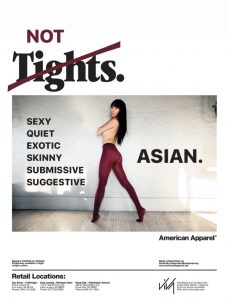Welcome to UBC Blogs. This is your first post. Edit or delete it, then start blogging!
Author Archives: MichelleChen
GRSJ 300 Culture Jam: American Apparel
Original Ad

American Apparel does not have exactly have a good reputation amongst feminist circles. There have been many controversies with the brand and how its ad campaigns make the models appear vulnerable by over sexualizing and objectifying women. American Apparel has always ridden this line between revolutionary and objectifying, playing with the ideas of generational fads and objectifying young female models since the beginning of when the brand has started (Maki 2015). Although it is important to be comfortable with human anatomy and accepting it for its beauty, intricacy, and design, there is a difference between art and sexualization.
The purpose of this ad is to market the brands tights to female consumers. However, attention to the product is redirected towards the Asian female model who is seen topless and flaunting her body. This had serious implications concerning gender and race.
Although it is argued that American Apparel advertisments are “promoting healthy sexuality”, however this example illustrates to us a young Asian female who is topless and flaunting her body. Other ads from the brand also portray the ideals of fair-skinned, slender and scantily dressed models. It is important to note that dehumanizing objectification of women’s bodies is not the same thing as “promoting healthy sexuality” (Tilden, 2014). The philosophy that underpins this ad is that “sex sells”. These ads create a false sense of attainable aspirations and lead the consumer to believe that dressing more revealing and exposing themselves will make them more attractive. The false sense of attainable aspirations is extremely damaging to one’s self-concept and body image. In addition, the ad also turns the focus of the consumer to the model and her body instead of on the product itself.
Another problem with this ad is that not only is this ad objectifying women, but it is also objectifying women of colour. In the western culture, Asian women have long been sexualized (Johnson, 2019). The bodies of Asian women are exoticized and hypersexualized, and the perceived submissiveness of some Asian cultures is glamourized and erotized (Dewey, 2016). Having an Asian women being overly sexualized in this campaign ads more to this stereotype. This fetishization reduces Asian women to an inaccurate and detrimental stereotype and create racial discrimination (Dewey, 2016).
Jammed Ad

In my jammed version of the advertisement, I made several modifications in attempt to accentuate the sexually contrived imagery of Asian women surrounding American Apparel’s marketing campaign. The first modification I made was to the caption. In order to emphasize that “tights” were not the product sold, I crossed out the word to put emphasis here that the brand was focusing on overly sexualizing and objectifying women. The next adjustment was to add the word “NOT.” above the word tights. Having both modifications makes it very obvious that American Apparel is only focusing on the model. Note that both the crossed line and word “NOT.” is in the colour of the model’s tights as a symbolism that the advertisement was not selling clothing.
The next modifications made were to put emphasis that women of colour, especially Asian women, are objectified with this advertisement. To remind the audience that the model is of Asian descent, the word “ASIAN.” is added to the right of the model. In addition, with Asian women long sexualized, exoticized and perceived as submissive in western culture, words to describe them were added to the left of the model. The added words serve as the final driving point of my culture jam. The words include: SEXY, QUIET, EXOTIC, SKINNY, SUBMISSIVE, AND SUGGESTIVE. This powerful action shows that these words here bring out the darkness of how Asian women are fantasized, fetishized and inaccurately discriminated by the western culture. With American Apparel already known to have controversial advertisements about objectifying women, having an Asian woman modelling in this ad just adds fuel to the fire. The company may have thought that using an Asian female model showed interested of the brand to be more diverse with ethnic groups, but however this was not the message it portrayed. Having an Asian female topless and flaunting her body only adds to the inaccurate and detrimental stereotype. By exploring the negative connotations and false image of the original advertisement, the purpose of my culture jam is to raise awareness of how American Apparels marketing campaigns can negatively affect body image, self-esteem to all women, especially Asian women.
Citations: